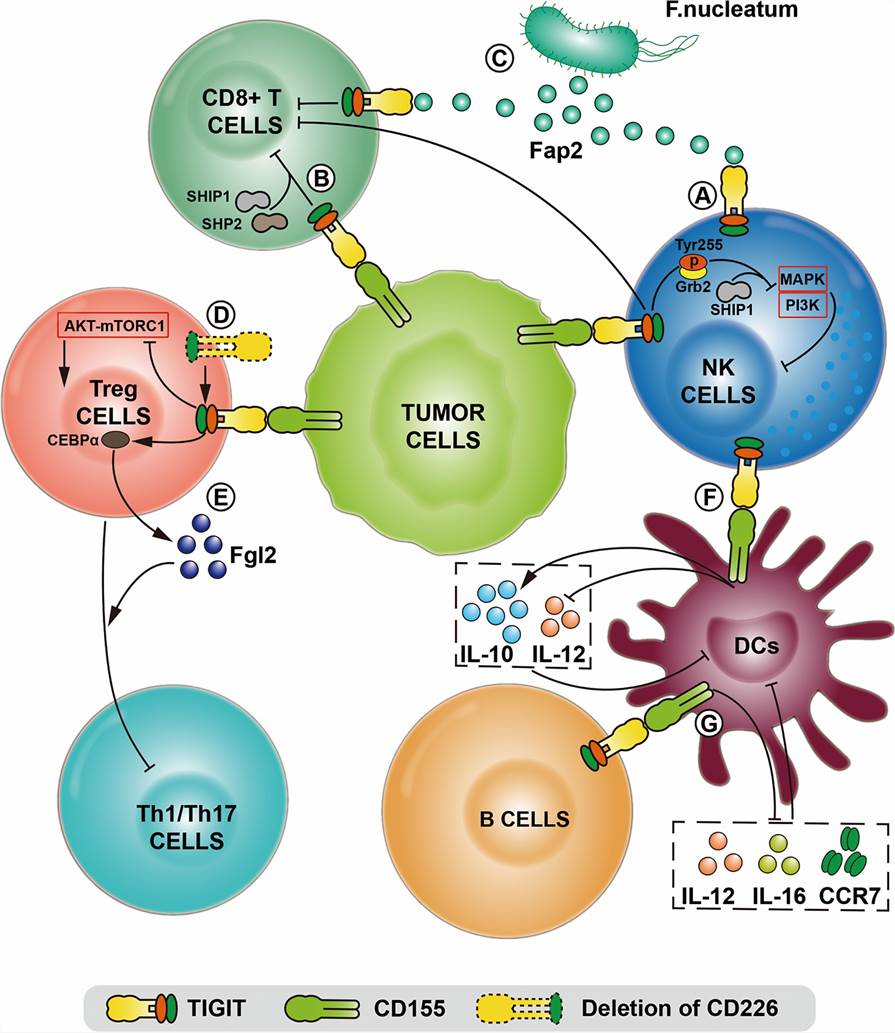CD155 is an adhesion molecule that is upregulated during tumor progression and promotes the proliferation and migration of tumor cells through multiple pathways. At Creative Biolabs, we aim to provide you with the theoretical support and technical assistance necessary for your research on immune checkpoint-related studies.
| Key Member | Names | Source | Functions |
| CD155 | Poliovirus receptor, NECL-5 | Monocytes, macrophages, thymocytes and CNS neurons | Mediates NK adhesion and triggers its function, participates in mediating tumor cell invasion and migration, and is also an attachment receptor for poliovirus. |
 Fig.1. Mechanisms of TIGIT/CD155.1,2
Fig.1. Mechanisms of TIGIT/CD155.1,2
CD155 is a significant member of the immunoglobulin superfamily, characterized by the presence of immunoglobulin-like domains V, C1, and C2 in its extracellular region. Notably, four splice isoforms of CD155 (α, β, γ, and δ) have been successfully identified. While CD155 is expressed at low levels or not at all in most healthy tissues, it exhibits remarkable overexpression in various human malignant tumors.
CD155 exerts its influence on tumor cells' proliferation, migration ability, and immune system function through diverse pathways. Specifically, CD155 interacts with CD226, TIGIT, and CD96, resulting in both co-stimulatory and co-inhibitory signals.
| Key Member | Features | Source | Functions |
| CD226 | Co-stimulatory | NK cells, T lymphocytes, monocytes, and B cells | Competes with TIGIT for binding to CD155. |
| TIGIT | Co-inhibitory | T cells and NK cells | Facilitates lymphocyte dysfunction and low reactivity, leading to immune evasion of tumor cells. |
| CD96 | Co-inhibitory | T cells and NK cells | Exerts immunosuppressive actions within the tumor microenvironment. CD96 inhibits the activity of CD8+ T cells and induces functional impairment |
CD155's abundant expression in tumor cells contributes to immune evasion strategies, primarily through three CD155-related pathways that inhibit adaptive immunity and T-cell function:
Moreover, elevated CD155 expression has been associated with enhanced invasive capabilities of tumor cells and their involvement in cell-matrix interactions.
CD155/TIGIT presents itself as a promising target for tumor immunotherapy. Current clinical interventions mainly focus on anti-TIGIT monoclonal antibodies or combination inhibitors. In vitro co-culture studies have demonstrated that anti-TIGIT treatment can effectively eliminate immune suppression of tumor cells by downregulating Arg1 and reducing TGF-β1 secretion.
At Creative Biolabs, our commitment extends beyond providing theoretical support and an in-depth understanding of CD155/TIGIT's role in tumors via our support page. We offer comprehensive service projects designed to provide you with technical assistance and diverse service options for the application of immune checkpoint inhibitors in tumor treatments. Contact us today to explore how our state-of-the-art solutions can propel your projects to new heights and revolutionize the way you approach immune checkpoint studies.
References
All listed customized services & products are for research use only, not intended for pharmaceutical, diagnostic, therapeutic, or any in vivo human use.
USA
Tel:
Fax:
Email:
Copyright © 2025 Creative Biolabs. All Rights Reserved.